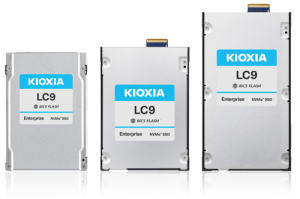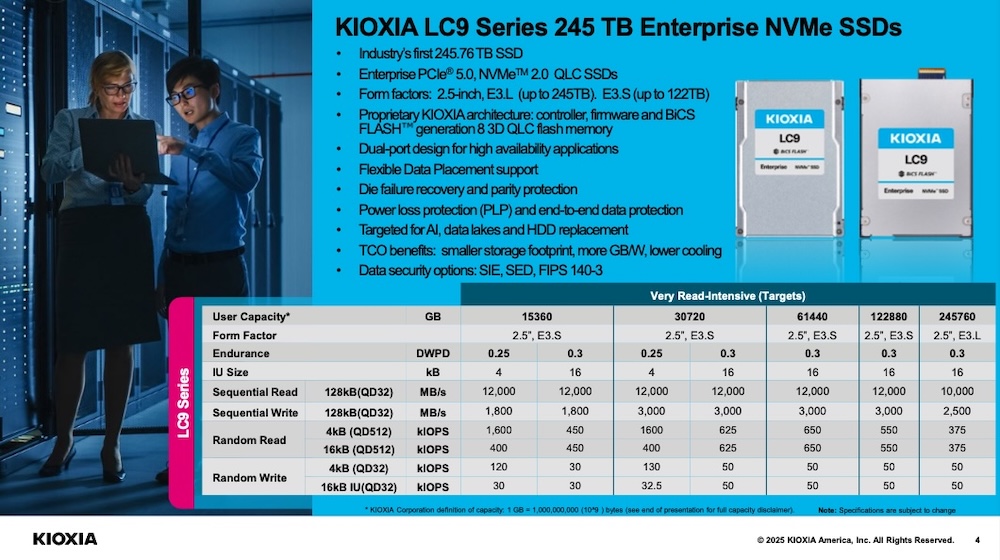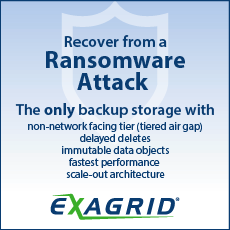Kioxia Unveils LC9 Series Up to 245.76TB PCIe 5.0 NVMe 2.5-Inch and EDSFF E3.L Form Factor SSD
And up to 122.88TB in E3.S form factor, including NVMe 2.0, NVMe-MI 1.2c specifications, OCP Datacenter NVMe SSD specification v2.5 support, and Flexible Data Placement (FDP) support to minimize write amplification and extend SSD lifespan
This is a Press Release edited by StorageNewsletter.com on July 23, 2025 at 2:02 pmKioxia Corporation has expanded its high-capacity LC9 Series enterprise SSD lineup by introducing the industry’s first (1) 245.76TB (2) NVMe SSD in 2.5-inch and EDSFF E3.L form factor.
 This new capacity and form factor option complements the previously announced 122.88 TB (2.5-inch) model and is purpose-built for the performance and efficiency demands of GenAI environments.
This new capacity and form factor option complements the previously announced 122.88 TB (2.5-inch) model and is purpose-built for the performance and efficiency demands of GenAI environments.
GenAI places unique demands on storage, including the need to store vast datasets for training large language models (LLMs), and to create embeddings and vector databases that support inference through retrieval augmented generation (RAG). These workloads require storage solutions with exceptional capacity, speed, and efficiency.
Featuring 32-die stack of 2Tb (3) BiCS FLASH QLC 3D flash memory with innovative CBA (CMOS directly Bonded to Array) technology, the company’s LC9 Series SSDs deliver the speed, scale, and density required to support the next wave of data-centric workloads. This combination of advanced memory architecture and CBA technology enables an 8TB (3) per small 154 BGA package – also an industry first (1). This milestone was made possible with Kioxia’s high-precision wafer processing, material design, and wire bonding technologies.
The firm’s LC9 Series SSDs are well-suited for data lakes, where massive data ingestion and rapid processing are essential. Unlike HDDs, which often bottleneck performance and leave costly GPUs underutilized, the LC9 Series SSDs enable dense storage in a compact footprint with greater capacity/watt. By delivering up to 245.76TB, they can replace multiple power-hungry HDDs, offering superior performance, lower overall power consumption, fewer drive slots used, and more efficient cooling. These features help drive TCO improvements across power, density, and thermal management.
Kioxia LC9 Series SSDs Features Include:
- Up to 245.76TB SSD in 2.5-inch and E3.L form factors
- Up to 122.88TB available in E3.S form factor
- Designed to PCIe 5.0 (max. 128GT/s Gen5 single x4, dual x2)
- NVMe 2.0, NVMe-MI 1.2c specifications
- Open Compute Project (OCP) Datacenter NVMe SSD specification v2.5 support (not all requirements)
- Flexible Data Placement (FDP) support to minimize write amplification and extend SSD lifespan (4)
- Security options: SIE, SED, FIPS SED
- CNSA 2.0 signing algorithm adopt (5), designed with future quantum security standards in mind
Kioxia LC9 Series SSDs are sampling to select customers and will be featured at the Future of Memory and Storage 2025 conference, taking place August 5 – 7 in Santa Clara, CA.
(1) As of July 22, 2025, based on Kioxia survey.
(2) Definition of SSD capacity: Kioxia Corporation defines a kilobyte (KB) as 1,000 bytes, a megabyte (MB) as 1,000,000 bytes, a gigabyte (GB) as 1,000,000,000 bytes, a terabyte (TB) as 1,000,000,000,000 bytes, and a kibibyte (KiB) is 1,024 bytes. A computer operating system, however, reports storage capacity using powers of 2 for the definition of 1GB = 2^30 bytes = 1,073,741,824 bytes and 1TB = 2^40 bytes = 1,099,511,627,776 bytes and therefore shows less storage capacity. Available storage capacity (including examples of various media files) will vary based on file size, formatting, settings, software and OS, and/or pre-installed software applications, or media content. Actual formatted capacity may vary.
(3) The flash memory capacity is calculated as 1 terabit (1Tb) = 1,099,511,627,776 (2^40) bits, and 1 terabyte (1TB) = 1,099,511,627,776 (2^40) bytes.
(4) For RocksDB purposes, Kioxia confirmed that the Write Amplification Factor (WAF) is approximately 1.1 when using the FDP function with the plug-in (a function extension program released on the Kioxia GitHub account. https://github.com/Kioxia-jp/ufrop).
(5) The Kioxia LC9 Series SSD supports Leighton-Micali Signature (LMS) algorithm acknowledged by CNSA 2.0 (Commercial National Security Algorithm Suite 2.0) as a digital signature algorithm to prevent firmware tampering in preparation for threats to conventional cryptographic algorithms posed by quantum computers. Advanced Encryption Standard (AES-256) with a key length of 256 bits, which is the data encryption algorithm used in Kioxia LC9 Series SSD, is also acknowledged by CNSA 2.0.
Comments
The SSD race is on as we approach FMS 2025. Kioxia is the first to unveil this high capacity data center drive as they refer to July 22, 2025. The LC9 has strong characteristics described above coupling 30 times 32 2Tb dies supporting PCIe Gen 5, NVMe 2.0 and QLC. It is based on Kioxia proprietary architecture and offers dual port. The firm also iterates on the 122TB capacity.
Click to enlarge
Click to enlarge
As said, FMS is around the corner and we expect announcements in the domain from several exhibitors and sponsors if we just refer to the keynote schedule. Some of them target connectivity supports and performance with PCIe Gen 6 support but less capacity, 30, 61 and 122TB being already impressive models. Many players have already a 61.44TB SSD which appear a "bit old now" with the current trend and a fraction have 122-128TB on their catalog.
Some other actors are absents of the expo floor but will leverage the moment to announce things as well, it is the case for Phison. It is also the return of SanDisk as an independent company after the split from WDC earlier this year and the announce a few months ago of the DC SN670 with 64 and 128TB based on UltraQLC design. We'll see if they'll take the opportunity to unveil a 240-250TB SSD to mark their presence. Some other actors should announce some developments around PCIe Gen 6 plus also new SSD controllers capabilities and of course NAND chip aspects...
















 Subscribe to our free daily newsletter
Subscribe to our free daily newsletter


